Related Research Articles

A wok is a deep round-bottomed cooking pan of Chinese origin. It is believed to be derived from the South Asian karahi. It is common in Greater China, and similar pans are found in parts of East, South and Southeast Asia, as well as being popular in other parts of the world.

Potash includes various mined and manufactured salts that contain potassium in water-soluble form. The name derives from pot ash, plant ashes or wood ash soaked in water in a pot, the primary means of manufacturing potash before the Industrial Era. The word potassium is derived from potash.

Saumagen is a German dish popular in the Palatinate. The dish is similar to a sausage in that it consists of a stuffed casing; however, the stomach itself is integral to the dish. It is not as thin as a typical sausage casing. Rather it is meat-like, being a strong muscular organ, and when the dish is finished by being pan-fried or roasted in the oven, it becomes crisp.
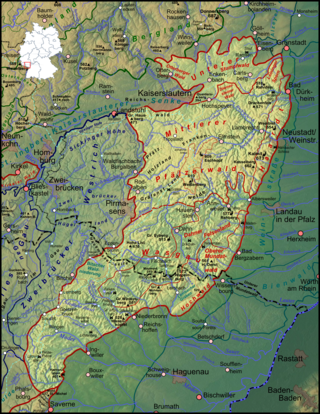
The Palatinate Forest, sometimes also called the Palatine Forest, is a low-mountain region in southwestern Germany, located in the Palatinate in the state of Rhineland-Palatinate. The forest is a designated nature park covering 1,771 km2 and its highest elevation is the Kalmit.
Leaching is a process widely used in extractive metallurgy where ore is treated with chemicals to convert the valuable metals within the ore, into soluble salts while the impurity remains insoluble. These can then be washed out and processed to give the pure metal; the materials left over are commonly known as tailings.

The lò trấu is a type of versatile fuel burning cook stove used in Vietnam since the 1950s. Lò trấu comes from lò (stove) and trấu. A kitchen with this kind of stove is a bếp trấu, "husk kitchen."

The Kalmit is the highest peak in the Palatinate Forest and the second highest in the Palatinate region of Germany. It is 672.6 m above sea level (NHN) and located 5.5 kilometres (3.4 mi) south of the town of Neustadt an der Weinstraße.

Wood ash is the powdery residue remaining after the combustion of wood, such as burning wood in a fireplace, bonfire, or an industrial power plant. It is largely composed of calcium compounds, along with other non-combustible trace elements present in the wood, and has been used for many purposes throughout history.

The Landau–Rohrbach railway is a major line running from Landau in the German state of Rhineland-Palatinate to Rohrbach in the Saarland. The main section between Landau and Zweibrücken was opened on 25 November 1875 after the first sections had already been opened between 1857 and 1867.
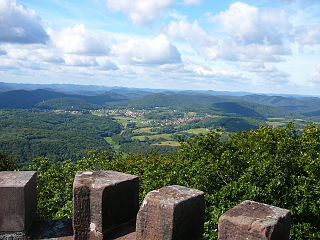
The Wasgau is a Franco-German hill range in the German state of Rhineland-Palatinate and the French departments of Bas-Rhin and Moselle. It is formed from the southern part of the Palatine Forest and the northern part of the Vosges mountains, and extends from the River Queich in the north over the French border to the Col de Saverne in the south.

The Frankenweide is a hill region in the German state of Rhineland-Palatinate. It forms the central part of the Palatine Forest in the Palatinate region.
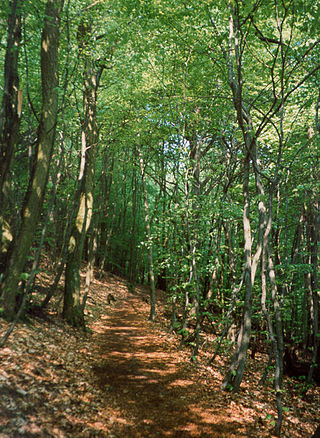
Walking routes in the Palatine Forest fall into two categories. The first are longer walking routes, most of which are maintained by the Palatine Forest Club, or PWV, and which are linked to the national and international network of long distance paths. The second category are those local circular walks and themed walking routes, some of which are of wider regional importance, and which are maintained by municipal authorities. The Palatine Forest, as part of the Palatine Forest-North Vosges Biosphere Reserve, is an important conservation area. As a result, the Palatine Forest, the bunter sandstone landscape of the Palatine Forest Nature Park, the castles in the Dahner Felsenland and the cross-border paths into Alsace and the Vosges make the region particularly popular with ramblers and walkers.

The Westrich Plateau, also Zweibrücken Westrich or Southwest Palatine Plateau, is a landscape in the German state of Rhineland-Palatinate, with small areas also in the Saarland (Saarpfalz-Kreis). Its heart is in the southwest of the Palatinate region and it is part of the historic region of Westrich.
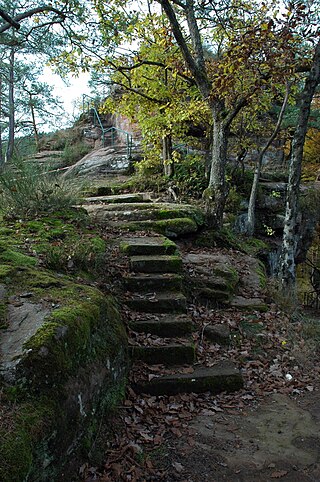
The Wilgartaburg, also called the Wiligartaburg, Wilgartsburg or Wiligartisburg, is the heritage site of a ruined rock castle located at a height of 245 m above sea level (NN) near the German village of Wilgartswiesen in the state of Rhineland-Palatinate.

Resin workers were people whose work involved the extraction or working of resin, which was needed as a raw material in the manufacture of pitch, tar and turpentine. Resin work was an occupation that largely died out in the 19th and 20th centuries, but it was sometimes a primary occupation as well as a secondary source of income.

The Brushmakers' Museum in Ramberg is a local history museum in the village of Ramberg in the German state of Rhineland-Palatinate. The responsible body that set the museum up in 1997 and has run it since then is the Local History and Museum Society of the Brushmakers' Workshop, Ramber.

The Kalmithaus, also called the Ludwigshafener Hut, near Maikammer in the Rhineland-Palatinate county of Südliche Weinstraße is a refuge hut in the Palatinate Forest run by the Ludwigshafen-Mannheim branch of the Palatinate Forest Club. It is located in the southern part of the Haardt mountains at the summit of its highest peak, the Kalmit, and is thus the highest hut in the Palatinate Forest. From its terrace there is "a splendid view of the Upper Rhine Plain and German Wine Road as far as the foothills of the southern Odenwald and northern Black Forest. Immediately next to the hut is the observation tower on the Kalmit, which is out of bounds to the public, and houses a radio relay station, a weather station and a visibility survey station.
A potash works was a subsidiary operation of a glassworks in the Early Modern Period. The latter needed potash, as well as quartz and lime as raw materials for the manufacture of glass. Potash acted as a flux in the production process, that is by mixing it with quartz sand it significantly reduced the melting point of the latter. To make potash the glassworks built potash huts or works in the vicinity, in which wood ash and vegetable ash was gathered by ash burners and initially washed in water and then vaporized; the whole process being known as leaching.
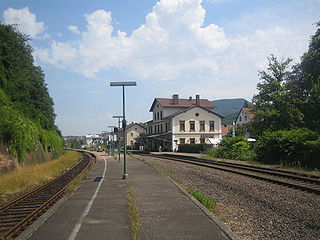
Annweiler am Trifels station is the main station in the town of Annweiler am Trifels in the German state of Rhineland-Palatinate. Deutsche Bahn classifies it as a category 5 station and it has three platform tracks. The station is located in the network of the Verkehrsverbund Rhein-Neckar and belongs to fare zones 181 and 191. Since 2002, Annweiler has also been part of the area served by the Karlsruher Verkehrsverbund using tickets at a transitional rate. Annweiler was always the most important station between Landau (Pfalz) Hbf and Pirmasens Nord and it used to be served by long-distance services.
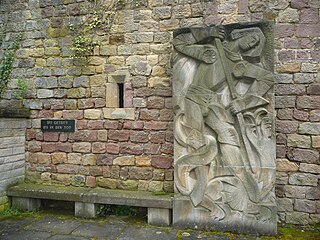
Otto Rumpf was a German sculptor.
References
- ↑ Helmut Seebach: Altes Handwerk und Gewerbe in der Pfalz. Vol. 3: Pfälzerwald. Waldbauern, Waldarbeiter, Waldprodukte- und Holzwarenhandel, Waldindustrie und Holztransport. Bachstelz-Verlag, Annweiler-Queichhambach et al., 1994, ISBN 3-924115-13-3, pp. 114ff.
- ↑ Helmut Seebach: Altes Handwerk und Gewerbe in der Pfalz. Vol. 3: Pfälzerwald. Waldbauern, Waldarbeiter, Waldprodukte- und Holzwarenhandel, Waldindustrie und Holztransport. Bachstelz-Verlag, Annweiler-Queichhambach et al., 1994, ISBN 3-924115-13-3, p. 116.